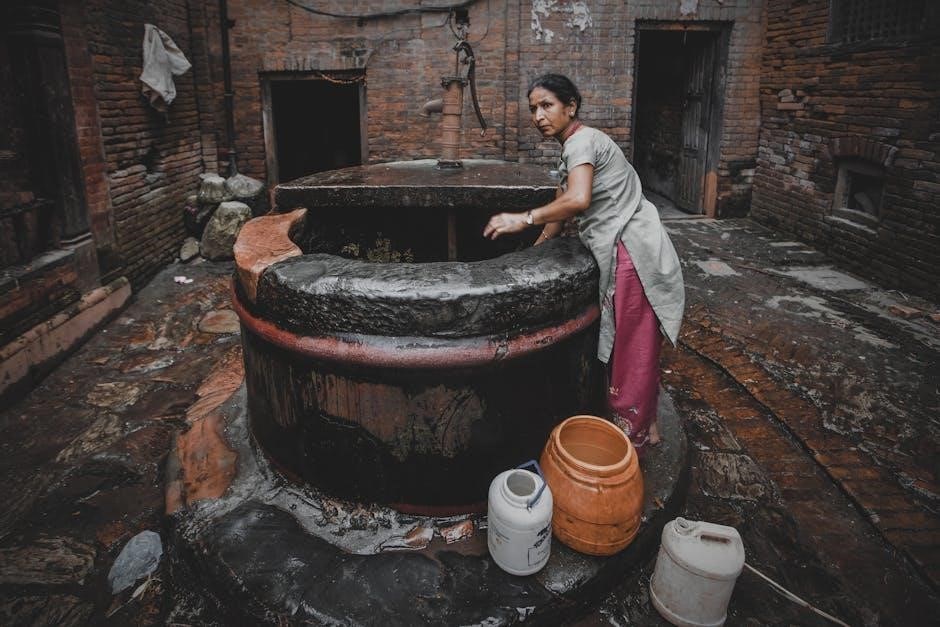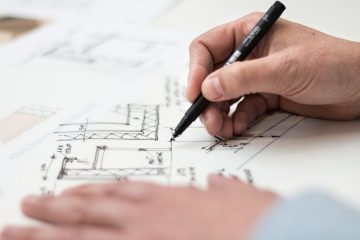This manual provides essential guidance for understanding, installing, and maintaining water well pumps. It covers key topics like system components, safety, and best practices for optimal performance.
By following the instructions, users can ensure efficient water supply while prolonging pump lifespan. Proper setup and maintenance are crucial for reliable operation and water quality.
Always refer to this manual before starting any installation or maintenance task to ensure safety and system longevity. It serves as a comprehensive resource for well pump management.
1.1 Overview of Water Well Systems
A water well system consists of a well, pump, casing, and screen, designed to extract water from underground aquifers. The pump moves water to the surface, while the casing and screen ensure efficient water flow. Pressure tanks store water and regulate system pressure, maintaining consistent supply. Understanding these components is key to ensuring reliable operation and water quality. Proper installation and maintenance are vital for long-term functionality and safety.
1.2 Importance of Proper Pump Installation and Maintenance
Proper installation and maintenance are crucial for ensuring a water well pump operates safely and efficiently. Incorrect installation can lead to system contamination or reduced pump lifespan. Regular maintenance prevents issues like worn parts and ensures reliable water supply. Always follow the manufacturer’s guidelines and perform routine checks to avoid costly repairs and maintain optimal water quality.
Installation and Wiring of Submersible Well Pumps
Proper installation and wiring of submersible well pumps ensure safe and efficient operation. Follow the manufacturer’s instructions and wiring diagrams to avoid electrical hazards and system failure.
2.1 Step-by-Step Guide for Installing a Deep Well Pump
- Assess the well depth and ensure the pump is compatible with the water level.
- Assemble the pump and motor according to the manufacturer’s instructions.
- Lower the pump into the well carefully, ensuring proper alignment and submersion.
- Connect the wiring to the control box, following the provided diagrams.
- Test the pump to ensure it operates smoothly and delivers water consistently.
- Secure all connections and monitor for leaks or unusual noise.
2.2 Understanding Wiring Diagrams and Control Boxes
Wiring diagrams provide a visual guide for connecting the pump, motor, and control box. They ensure proper electrical connections for safe and efficient operation. The control box regulates the pump’s power supply and protects it from voltage fluctuations. It typically includes a pressure switch, capacitor, and circuit breaker. Always follow the manufacturer’s wiring instructions to avoid electrical hazards and ensure reliable performance. Proper setup guarantees optimal pump functionality and longevity.
Safety Precautions and Operating Manual
Always disconnect power before servicing the pump. Follow manual guidelines to avoid electrical hazards. Proper installation and operation ensure safe and efficient water supply. Regular inspections prevent potential risks. Adhere to manufacturer’s instructions for longevity and reliability. Safety measures protect both the system and users. This manual is your key to safe and effective pump operation.
3.1 Essential Safety Measures for Well Pump Operation
Always read the operator’s manual before starting any operation. Install a pressure relief valve to prevent system overpressure. Ensure the pump is never operated without water to avoid damage. Disconnect power before servicing to prevent electrical shocks. Regularly inspect wiring and connections for wear. Keep the wellhead and surrounding area clean to prevent contamination. Never exceed the pump’s rated capacity. Follow all safety guidelines to ensure reliable operation and protect against hazards. Schedule professional inspections for complex tasks.
3.2 Reading and Following the Operator’s Manual
Thoroughly read the operator’s manual before initial use to ensure safe and efficient operation. Understand installation steps, wiring diagrams, and troubleshooting tips. Adhere to recommended maintenance schedules and safety guidelines. Refer to the manual regularly to address service concerns and optimize performance. Properly following the manual ensures reliable operation, extends pump lifespan, and helps maintain water quality. It’s a vital resource for addressing common issues and ensuring system longevity.

Maintenance and Troubleshooting
Regular maintenance ensures optimal pump performance and prolongs its lifespan. Identify and address issues promptly to prevent system failures. Troubleshooting common problems quickly ensures reliable water supply.
4.1 Routine Maintenance Tasks for Longevity
Regular maintenance is crucial for extending the life of your water well pump. Check pressure settings, inspect wiring, and clean intake screens monthly. Replace worn or damaged parts promptly to prevent system failure. Monitor water flow rates and pressure levels for consistency. Annual professional inspections are recommended to ensure optimal performance. Keep the well casing and surrounding area clear of debris to maintain proper function.
4.2 Common Issues and Troubleshooting Tips
Common issues include low water pressure, excessive noise, or pump failure. If the pressure tank won’t hold pressure, check for leaks or faulty valves. If the pump runs dry, ensure proper water supply and inspect intake screens. For low water flow, clean or replace clogged filters. Irregular cycling may indicate faulty pressure switches or incorrect settings. Always refer to the manual for specific troubleshooting steps.

Understanding Well Pressure Tanks and Switches
Pressure tanks store water under pressure, while switches regulate pump operation. Proper setup ensures consistent water supply and protects the system from damage. Regular maintenance is crucial.
5.1 Function and Importance of Pressure Tanks
Pressure tanks are essential for stabilizing water pressure in well systems. They store water under pressure, reducing pump cycling and ensuring a steady supply. Properly sized tanks prevent pressure fluctuations, protecting pipes and fixtures from damage. Regular maintenance, such as checking pressure settings and ensuring the tank is appropriately charged, is vital for optimal performance and system longevity.
5.2 Proper Setup and Adjustment of Pressure Switches
Proper setup and adjustment of pressure switches ensure consistent water pressure and protect the system from damage. Follow the manufacturer’s manual for specific instructions. Typically, set the cut-in pressure (low) and cut-out pressure (high) within a 20-psi differential. For most residential systems, a range of 30-50 psi is standard. Test the system after adjustments to ensure smooth operation. Regular inspections and adjustments are crucial for maintaining reliability and preventing issues.
Selecting the Right Pump for Your Well
Selecting the right pump involves considering water depth, flow rate, and pump type. Submersible pumps are ideal for deep wells, while jet pumps suit shallower applications.
6.1 Factors to Consider: Water Depth and Flow Rate
Assessing water depth and flow rate is crucial for selecting the right pump. Deeper wells require submersible pumps, while shallower wells may use jet pumps. Measure the well’s water level and calculate the required flow rate. Ensure the pump’s horsepower matches these factors. Proper sizing ensures efficient operation and prevents overwork. Consider peak water usage needs and pressure requirements. Incorrect sizing can lead to poor performance or premature wear. Always consult a professional for accurate assessment and recommendations to ensure optimal pump performance and longevity.

6.2 Choosing Between Submersible and Jet Pumps

Submersible pumps are ideal for deep wells, operating quietly and efficiently by pushing water upward. Jet pumps are better for shallow wells, using suction to pull water. Consider water depth, flow rate, and pressure requirements. Submersible pumps handle deeper depths (below 25 feet) and higher demands. Jet pumps are cost-effective for shallower applications (above 25 feet). Choose based on well specifics and usage needs for optimal performance and longevity.

Monitoring and Testing Your Well Water

Regular water testing ensures safety and quality. Check for bacteria, nitrates, and contaminants. Use certified labs for accurate results. This helps maintain a safe water supply and health.
7.1 Regular Water Quality Testing
Regular water quality testing is crucial for ensuring your well water is safe. Test for bacteria, nitrates, and contaminants annually or after system changes. Use certified labs for accurate results. This helps identify potential issues early, protecting your health and water supply. Consistent monitoring ensures water remains clean and safe for consumption and household use. Always follow local regulations and expert recommendations for testing frequency and procedures.
7.2 Interpreting Test Results for Safe Usage
Understanding your water test results is key to ensuring safe usage. Compare results against local and national safety standards to identify contaminants. High levels of bacteria, nitrates, or heavy metals may require treatment. Address issues promptly to prevent health risks. Retest after corrections to confirm water safety. Always consult professionals if unsure about results or necessary actions to ensure your water supply remains safe and reliable for all uses.

Saving Energy and Water with Pump Automation
This section explores how automation enhances energy and water efficiency in well pump systems. Installing pressure sensors and smart controls optimizes water usage and reduces energy waste, promoting sustainability and cost savings through advanced monitoring and precise operation.
8.1 Installing Pressure Sensors and Automations
Installing pressure sensors and automations optimizes your well pump system’s efficiency. Pressure sensors monitor water pressure, ensuring consistent flow and preventing overwork. Automations like float switches and timers regulate operation, reducing energy use. Follow the manufacturer’s wiring diagram and manual instructions for proper setup. Use weatherproof connectors and ground the system for safety. Regularly test sensors to ensure accuracy and adjust settings as needed for optimal performance. This enhances reliability and extends equipment lifespan. Always consult the owner’s manual for specific installation guidance.
8.2 Benefits of Energy-Efficient Pump Systems
Energy-efficient pump systems offer significant advantages, including reduced electricity consumption and lower operational costs. They minimize wear and tear, extending the pump’s lifespan. These systems often operate quietly and produce less heat, enhancing reliability. By optimizing water flow and pressure, they ensure consistent performance while being environmentally friendly. Investing in energy-efficient solutions can also qualify for rebates or tax incentives, providing long-term savings and peace of mind.
Environmental and Regulatory Considerations

Protecting your well from contamination and adhering to local water usage regulations are crucial for environmental sustainability and legal compliance, ensuring safe and responsible water management practices.
9.1 Protecting Your Well from Contamination
Regular water quality testing is essential to detect potential contaminants. Proper installation and sealing of the well casing prevent surface water infiltration. Keep the wellhead clear of debris and chemicals. Avoid locating wells near septic systems or agricultural runoff. Inspect the well annually for signs of damage or wear. Dispose of hazardous waste properly to safeguard groundwater. Regular maintenance ensures the well remains a safe and reliable water source.
9.2 Adhering to Local Water Usage Regulations
Before installing or operating your well pump, verify local water usage regulations. These rules often dictate permissible extraction limits and environmental protection measures. Ensure compliance to avoid fines or system shutdowns. Regularly consult with local authorities to stay updated on any changes in water usage policies. Proper adherence ensures sustainable water resource management and prevents legal complications. Always maintain detailed records of water usage for inspection purposes if required.
This manual provides a comprehensive guide to water well pump systems, ensuring safe and efficient operation. For further learning, explore additional resources like the Well Owners Manual and industry guides.
10.1 Summary of Best Practices
Always install a pressure relief valve to ensure safe operation. Regularly inspect and maintain pump components to prevent failure. Follow the operator’s manual for specific guidelines. Test water quality annually and address any issues promptly. Keep detailed records of maintenance and repairs. Properly winterize the system to avoid freezing. Ensure all electrical connections are secure and meet local codes. Prioritize energy efficiency and water conservation for long-term sustainability.
10.2 Recommended Manuals and Guides for Further Reading
Consult the Well Owners Manual for detailed insights on water well systems and maintenance. Review installation guides and troubleshooting tips from Water Pumps Direct. Explore resources on water quality testing and energy-efficient systems. Check local regulations for compliance. Use manufacturer-specific manuals for precise instructions. Visit the wellcare Hotline for additional support. These resources will help optimize your well pump system and ensure long-term reliability and safety.



0 Comments